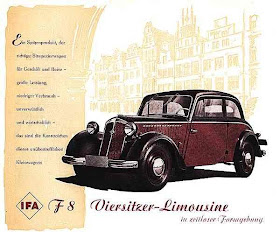
In the chaos of the immediate post-war years DKW was forced to re-establish itself virtually from scratch. The nationalization of Auto-Union’s factories in the east meant not only a forced relocation to Ingolstadt in Bavaria, but the loss of access to the company’s designs. Some blueprints and research materials were smuggled to the west and placed in the hands of the new company. Agents were sent out to the company's extensive sales and service network in an effort to recover designs, tooling and service manuals. These efforts enabled the new company to begin manufacturing spare parts for prewar cars and motorcycles from 1946. From this small start the company began planning a return to motor vehicle manufacture.
Over in East Germany, in 1948 the nationalized DKW factory, now renamed IFA, had managed to recommence production of the wood bodied, prewar F8. Although IFA had lost access to the Spandau bodywork factory in Berlin, other companies were able to take over the manufacture of this model's wooden bodies.

DKW also considered resurrecting the F8 to get back into car manufacture, but they too had lost access to the Spandau Karosserie. Several bodyshops, such as Holka in Switzerland and Baur of Stuttgart, both of whom had built bodies for DKW before the war presented proposals. DKW's problems were more acute however. Their meagre production facilities at Ingolstadt was not capable of the mass production of either engines or chassis, being barely sufficient to maintain spare parts supply.
In 1948 the entire focus of the company was on the development of the new DKW Schnellaster van, followed by the recommencement of motorcycle production with the 125/W. Both these vehicles went on sale in 1949 and were well received but what the dealer network really wanted was a new passenger car. The company promised that they would have a sedan on the market before 1950, but this seemed unrealistic. A new passenger car project, called the FX, was underway but was making slow progress. To keep the dealers onside a temporary solution was called for.

Karosserie Baur from Stuttgart, who had bodied a range of luxury vehicles for Auto-Union before the war, had offered DKW an all steel replacement body for the F7-F8 platform in 1947. DKW now accepted the offer and agreed to begin supplying F8 chassis and engines directly to Baur. DKW had a large stock of 688cc two-cylinder, two-stroke engines on hand, but its stock of F8 chassis was largely made up from damaged and scrapped pre-war cars. In 1949 only 22 new F8 chassis trickled off their production line, which were then sent to Baur.

The Baur bodied DKW was named the F10 - the F8 being DKW’s last pre-war car, while the F9 was DKW’s still-born modern, steel-bodied car of 1940.

DKW's first post-war cars - the DKW F89L schnellaster van and the F10 at Ingolstadt.
The new car went on sale in January 1950. DKW produced its own F10 advertising, primarily for the export market. The majority of DKW F10s were sold outside Germany. Baur also advertised the F10 independently as a replacement for cars with damaged or worn wooden bodies.

Despite the car’s good looks, it was only on sale for a very short time, being removed from sale by DKW in August 1950, after less than 200 cars had been sold. By this time, DKW’s Dusseldorf factory was ready to begin production of a different compromise vehicle - the DKW F89P. DKW had managed to secure possession F9 body presses from the Allgaier tooling company and had been able to begin manufacturing their own panels which were mounted over a modified DKW F8 running gear. By late 1950 the new car was ready to roll, thereby removing the need for the partially outsourced F10.

Horch and Audi founder, August Horch, with the new DKW F89. Despite its modern appearance it was effectively a re-bodied pre-war F8, just like the F10.
Baur continued to manufacture the F10 for some time afterward as a replacement body for older F8s. It’s believed that almost half of the 380 odd F10s built were re-bodied old F8s.

But that wasn't the end. IFA in East Germany approached Baur and obtained the rights to build their four seater cabriolet. IFA built 150 F10s on Baur's behalf. All these IFA built cars were exported outside Germany.

In 1953 the state automotive collective, VEB, restructured the East German auto industry to reduce the number of models being manufactured. As IFA was producing the F9, the older F8 was retired, but several hundred chassis and engines remained in stock. BMW's old factory at Eisenach (EMW) had been instructed to stop producing its handsome EMW 328 roadster, EMW took the opportunity to body the F8s. EMW combined the styling of the Baur cabriolet with their own roadster to produce an delightful looking roadster. The F8 Luxus Cabriolet was targeted at the western export market and more than one third of the 400 odd cars was sold in the west.

DKW F10 Brochure: https://dkwautounionproject.blogspot.com/2020/03/dkw-f10-brochure.html
DKW F10 - The First Born: https://dkwautounionproject.blogspot.com/2020/03/the-first-born-dkw-f10.html
No comments:
Post a Comment